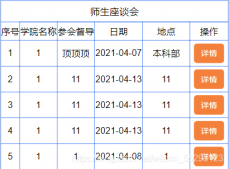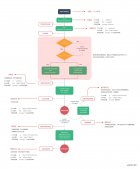前言
在Vue中,data选项是个好东西,把数据往里一丢,在一个Vue组件中任何一个地方都可以通过this来读取data中数据。但是要避免滥用this去读取data中数据,至于在哪里要避免滥用,如果滥用会导致什么后果,本专栏将会一一揭晓。
一、用this读取data中数据的过程
在Vue源码中会把data中数据添加getter函数和setter函数,将其转成响应式的。getter函数代码如下所示:
|
1
2
3
4
5
6
7
8
9
10
11
12
13
|
function reactiveGetter() { var value = getter ? getter.call(obj) : val; if (Dep.target) { dep.depend(); if (childOb) { childOb.dep.depend(); if (Array.isArray(value)) { dependArray(value); } } } return value} |
用this读取data中数据时,会触发getter函数,在其中通过 var value = getter ? getter.call(obj) : val; 获取到值后执行 return value,实现读取数据的目的。
这里可以得出一个结论,在Dep.target存在时,使用this去读取data中数据时会去收集依赖。如果滥用this去读取data中数据,会多次重复地收集依赖,从而产生性能问题。
二、Dep.target什么时候存在
Dep.target是由依赖赋值的。依赖又称为Watcher(侦听者)或者订阅者。在Vue中有三种依赖,其中两种是很常见的,就是watch(侦听器)和computed(计算属性)。还有一种隐藏的依赖———渲染Watcher,在模板首次渲染的过程中创建的。
Dep.target是在依赖创建时被赋值,依赖是用构造函数Watcher创建。
|
1
2
3
4
5
6
7
8
9
10
11
12
13
14
15
16
17
18
19
20
21
22
23
24
|
function Watcher(vm, expOrFn, cb, options, isRenderWatcher) { //... if (typeof expOrFn === 'function') { this.getter = expOrFn; } else { this.getter = parsePath(expOrFn); } this.value = this.lazy ? undefined : this.get();};Watcher.prototype.get = function get() { pushTarget(this); try { value = this.getter.call(vm, vm); } catch (e) { } return value};Dep.target = null;var targetStack = [];function pushTarget(target) { targetStack.push(target); Dep.target = target;} |
在构造函数Watcher最后会执行实例方法get,在实例方法get中执行pushTarget(this)中给Dep.target赋值的。
而依赖是在Vue页面或组件初次渲染时创建,所以产生的性能问题应该是首次渲染过慢的问题。
三、在何处滥用this去读取data中数据
在Dep.target存在时去执行这些滥用this去读取data中数据的代码会产生性能问题,故还要搞清楚这些代码是写在哪里才会被执行到,换句话来说,要搞清楚在哪里滥用this去读取data中数据会产生性能问题。
在第二小节中介绍了Dep.target被赋值后会执行value = this.getter.call(vm, vm),其中this.getter是一个函数,那么若在其中有用this去读取data数据,就会去收集依赖,假如滥用的话就会产生性能问题。
this.getter是在创建依赖过程中赋值的,每种依赖的this.getter都是不相同的。下面来一一介绍。
-
watch(侦听器)依赖的
this.getter是parsePath函数,其函数参数就是侦听的对象。
|
1
2
3
4
5
6
7
8
9
10
11
12
13
14
15
16
|
var bailRE = new RegExp(("[^" + (unicodeRegExp.source) + ".$_\\d]"));function parsePath(path) { if (bailRE.test(path)) { return } var segments = path.split('.'); return function(obj) { for (var i = 0; i < segments.length; i++) { if (!obj) { return } obj = obj[segments[i]]; } return obj }} |
如下所示的代码中的 a 和 a.b.c作为参数传入parsePath函数会返回一个函数赋值给this.getter,执行this.getter.call(vm, vm)会得到this.a和this.a.b.c的值。在这个过程中不会存在滥用this去读取data中数据的场景。
|
1
2
3
4
5
6
7
8
|
watch:{ a:function(newVal, oldVal){ //做点什么 }}vm.$watch('a.b.c', function (newVal, oldVal) { // 做点什么}) |
-
computed(计算属性)依赖的
this.getter有两种,如果计算属性的值是个函数,那么this.getter就是这个函数。如果计算属性的值是个对象,那么this.getter就是这个对象的get属性值,get属性值也是个函数。在这个函数可能会存在滥用this去读取data中数据的场景,举个例子,代码如下所示。
|
1
2
3
4
5
6
7
8
9
10
11
12
13
|
computed:{ d:function(){ let result = 0; for(let key in this.a){ if(this.a[key].num > 20){ result += this.a[key].num + this.b + this.c; }else{ result += this.a[key].num + this.e + this.f; } } return result; }} |
在计算属性d中就存在滥用this去读取data数据。其中this.a是个数组,此时Dep.target的值为计算属性d这个依赖,在循环this.a中使用this去获取中a、b、c、e、f的数据,使这些数据进行一系列复杂的逻辑运算来重复地收集计算属性d这个依赖。导致获取计算属性d的值的速度变慢,从而产生性能问题。
-
渲染Watcher的
this.getter是一个函数如下所示:
|
1
2
3
|
updateComponent = function() { vm._update(vm._render(), hydrating);}; |
其中vm._render()会把template模板生成的渲染函数render转成虚拟DOM(VNode):vnode = render.call(vm._renderProxy, vm.$createElement);,举一个例子来说明一下渲染函数render是什么。
例如template模板:
|
1
2
3
4
5
|
<template> <div class="wrap"> <p>{{a}}<span>{{b}}</span></p> </div></template> |
通过vue-loader会生成渲染函数render,如下所示:
|
1
2
3
4
5
6
7
8
9
|
(function anonymous() { with(this) { return _c('div', { attrs: { "class": "wrap" } }, [_c('p', [_v(_s(a)), _c('span', [_v(_s(b))])])]) }}) |
其中with语句的作用是为一个或一组语句指定默认对象,例with(this){ a + b } 等同 this.a + this.b,那么在template模板中使用{{ a }}相当使用this去读取data中的a数据。故在template模板生成的渲染函数render中也可能存在滥用this去读取data中数据的场景。举个例子,代码如下所示:
|
1
2
3
4
5
6
7
8
|
<template> <div class="wrap"> <div v-for=item in list> <div> {{ arr[item.index]['name'] }} </div> <div> {{ obj[item.id]['age'] }} </div> </div> </div></template> |
其中用v-for循环list数组过程中,不断用this去读取data中arr、obj的数据,使这些数据进行一系列复杂的逻辑运算来重复收集这个依赖,导致初次渲染的速度变慢,从而产生性能问题。
四、如何避免滥用this去读取data中数据
综上所述在计算属性和template模板中滥用this去读取data中数据会导致多次重复地收集依赖,从而产生性能问题,那要怎么避免这种情况。
- 计算属性中如何避免
用ES6对象解构赋值来避免,计算属性的值是一个函数,其参数是Vue的实例化this对象,在上述计算属性中滥用this的例子中可以这样优化。
优化前:
|
1
2
3
4
5
6
7
8
9
10
11
12
13
|
computed:{ d:function(){ let result = 0; for(let key in this.a){ if(this.a[key].num > 20){ result += this.a[key].num + this.b + this.c; }else{ result += this.a[key].num + this.e + this.f; } } return result; }} |
优化后:
|
1
2
3
4
5
6
7
8
9
10
11
12
13
|
computed: { d({ a, b, c, e, f }) { let result = 0; for (let key in a) { if (a[key].num > 20) { result += a[key].num + b + c; } else { result += a[key].num + e + f; } } return result; }} |
以上利用解构赋值提前把data数据中的a、b、c、e、f赋值给对应的变量a、b、c、e、f,然后在计算属性中可以通过这些变量访问data数据的,且不会触发data中对应数据的依赖收集。这样只用this读取了一次data中的数据,只触发了一次依赖收集,避免了多次重复地依赖收集产生的性能问题。
- template模板中如何避免
提前处理v-for循环所用的数据,不要在v-for循环中去读取数组、对象类型的数据。在上述template模板中滥用this的例子中可以这样优化。
假设list、arr、obj皆是服务端返回来的数据,且arr和obj没有用到任何模块渲染中,可以这样优化。
优化前:
|
1
2
3
4
5
6
7
8
|
<template> <div class="wrap"> <div v-for=item in list> <div> {{ arr[item.index]['name'] }} </div> <div> {{ obj[item.id]['age'] }} </div> </div> </div></template> |
优化后:
|
1
2
3
4
5
6
7
8
9
10
11
12
13
14
15
16
17
18
19
20
21
22
23
24
25
26
27
28
|
<template> <div class="wrap"> <div v-for=item in listData> <div{{item.name}} </div> <div>{{item.age}}</div> </div> </div></template><script>const arr = [];const obj = {}export default { data() { return { list: [], } }, computed: { listData: function ({list}) { list.forEach(item => { item.name = arr[item.index].name; item.age = obj[item.id].age; }) return list; } },}</script> |
以上就是Vue中避免滥用this去读取data中数据的详细内容,更多关于Vue中避免滥用this的资料请关注服务器之家其它相关文章!
原文链接:https://juejin.cn/post/6934911314871451685



















